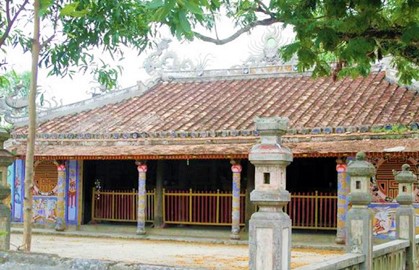The overall architecture of Dinh Chiet Bi includes several structures: the representative pillar, the ceremonial gate, the screen, the courtyard, and the communal house itself.
The communal house's architecture follows the traditional style of Huế, featuring three sections and two wings, with a tiled yin-yang roof. The eaves are adorned with ornamental tiles, and the central ridge has a sun motif, while dragon images grace the roof ends. The embankments on both sides are adorned with four mythical creatures: dragons, lions, turtles, and phoenixes. Decorative foliage and trees are artistically crafted on the embankments. Bat images, symbolizing prosperity, are also made of cement on the front roof ends. These motifs not only serve as artistic highlights but also express the aspirations of the villagers for harmony, prosperity, and well-being.
The main hall is equipped with a system of altars for ancestral worship in all three sections. These altars, previously made of wood, have been recreated using faux wood cement and meticulously painted and decorated. The surrounding areas of the altars are divided into compartments with square and rectangular patterns, each decorated with stylized foliage. The front of the main altar features a "tiger statuette." Above the altars are various ancestral worship items like candle holders, water trays, and incense burners. The space between the altars showcases pairs of Han-script couplets that praise the peaceful and serene countryside life of the Vietnamese village.
The rear chamber can be accessed from the main hall through side doors. Like the main hall, it contains three altars built into the walls, reconstructed using faux wood cement. The altars also hold various worship items like candle holders, water trays, incense burners, and flower vases.
Long cement benches are constructed on either side of the side wings, used for preparing ceremonial offerings and holding meetings during village festivals.
In addition to the main structures, Dinh Chiet Bi also has a monk's house (now the Chiet Bi Village Cultural House). The monk's house was rebuilt due to deterioration and is used for meetings and preparing offerings during memorial ceremonies and village festivals.
